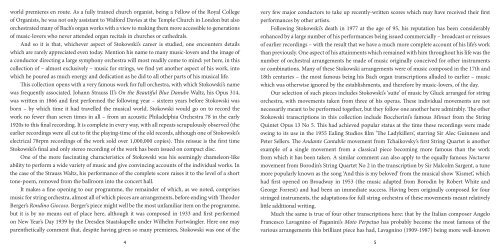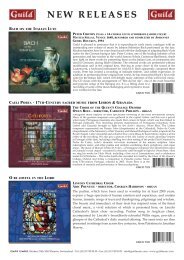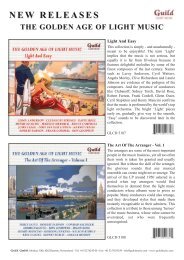Johann STRAUSS II (1825-1899) – On the Beautiful Blue Danube 9 ...
Johann STRAUSS II (1825-1899) – On the Beautiful Blue Danube 9 ...
Johann STRAUSS II (1825-1899) – On the Beautiful Blue Danube 9 ...
You also want an ePaper? Increase the reach of your titles
YUMPU automatically turns print PDFs into web optimized ePapers that Google loves.
world premieres en route. As a fully trained church organist, being a Fellow of <strong>the</strong> Royal College<br />
of Organists, he was not only assistant to Walford Davies at <strong>the</strong> Temple Church in London but also<br />
orchestrated many of Bach’s organ works with a view to making <strong>the</strong>m more accessible to generations<br />
of music-lovers who never attended organ recitals in churches or ca<strong>the</strong>drals.<br />
And so it is that, whichever aspect of Stokowski’s career is studied, one encounters details<br />
which are rarely appreciated even today. Mention his name to many music-lovers and <strong>the</strong> image of<br />
a conductor directing a large symphony orchestra will most readily come to mind: yet here, in this<br />
collection of <strong>–</strong> almost exclusively <strong>–</strong> music for strings, we find yet ano<strong>the</strong>r aspect of his work, into<br />
which he poured as much energy and dedication as he did to all o<strong>the</strong>r parts of his musical life.<br />
This collection opens with a very famous work for full orchestra, with which Stokowski’s name<br />
was frequently associated. <strong>Johann</strong> Strauss <strong>II</strong>’s <strong>On</strong> <strong>the</strong> <strong>Beautiful</strong> <strong>Blue</strong> <strong>Danube</strong> Waltz, his Opus 314,<br />
was written in 1866 and first performed <strong>the</strong> following year <strong>–</strong> sixteen years before Stokowski was<br />
born <strong>–</strong> by which time it had travelled <strong>the</strong> musical world. Stokowski would go on to record <strong>the</strong><br />
work no fewer than seven times in all <strong>–</strong> from an acoustic Philadelphia Orchestra 78 in <strong>the</strong> early<br />
1920s to this final recording. It is complete in every way, with all repeats scrupulously observed (<strong>the</strong><br />
earlier recordings were all cut to fit <strong>the</strong> playing-time of <strong>the</strong> old records, although one of Stokowski’s<br />
electrical 78rpm recordings of <strong>the</strong> work sold over 1,000,000 copies). This reissue is <strong>the</strong> first time<br />
Stokowski’s final and only stereo recording of <strong>the</strong> work has been issued on compact disc.<br />
<strong>On</strong>e of <strong>the</strong> more fascinating characteristics of Stokowski was his seemingly chameleon-like<br />
ability to perform a wide variety of music and give convincing accounts of <strong>the</strong> individual works. In<br />
<strong>the</strong> case of <strong>the</strong> Strauss Waltz, his performance of <strong>the</strong> complete score raises it to <strong>the</strong> level of a short<br />
tone-poem, removed from <strong>the</strong> ballroom into <strong>the</strong> concert hall.<br />
It makes a fine opening to our programme, <strong>the</strong> remainder of which, as we noted, comprises<br />
music for string orchestra, almost all of which pieces are arrangements, before ending with Theodor<br />
Berger’s Rondino Giocoso. Berger’s piece might well be <strong>the</strong> most unfamiliar item on <strong>the</strong> programme,<br />
but it is by no means out of place here, although it was composed in 1933 and first performed<br />
on New Year’s Day 1939 by <strong>the</strong> Dresden Staatskapelle under Wilhelm Furtwängler. Here one may<br />
paren<strong>the</strong>tically comment that, despite having given so many premieres, Stokowski was one of <strong>the</strong><br />
very few major conductors to take up recently-written scores which may have received <strong>the</strong>ir first<br />
performances by o<strong>the</strong>r artists.<br />
Following Stokowski’s death in 1977 at <strong>the</strong> age of 95, his reputation has been considerably<br />
enhanced by a large number of his performances being issued commercially <strong>–</strong> broadcast or reissues<br />
of earlier recordings <strong>–</strong> with <strong>the</strong> result that we have a much more complete account of his life’s work<br />
than previously. <strong>On</strong>e aspect of his attainments which remained with him throughout his life was <strong>the</strong><br />
number of orchestral arrangements he made of music originally conceived for o<strong>the</strong>r instruments<br />
or combinations. Many of <strong>the</strong>se Stokowski arrangements were of music composed in <strong>the</strong> 17th and<br />
18th centuries <strong>–</strong> <strong>the</strong> most famous being his Bach organ transcriptions alluded to earlier <strong>–</strong> music<br />
which was o<strong>the</strong>rwise ignored by <strong>the</strong> establishments, and <strong>the</strong>refore by music-lovers, of <strong>the</strong> day.<br />
Our selection of such pieces includes Stokowski’s ‘suite’ of music by Gluck arranged for string<br />
orchestra, with movements taken from three of his operas. These individual movements are not<br />
necessarily meant to be performed toge<strong>the</strong>r, but <strong>the</strong>y follow one ano<strong>the</strong>r here admirably. The o<strong>the</strong>r<br />
Stokowski transcriptions in this collection include Boccherini’s famous Minuet from <strong>the</strong> String<br />
Quintet Opus 13 No 5. This had achieved popular status at <strong>the</strong> time <strong>the</strong>se recordings were made<br />
owing to its use in <strong>the</strong> 1955 Ealing Studios film ‘The Ladykillers’, starring Sir Alec Guinness and<br />
Peter Sellers. The Andante Cantabile movement from Tchaikovsky’s first String Quartet is ano<strong>the</strong>r<br />
example of a single movement from a classical piece becoming more famous than <strong>the</strong> work<br />
from which it has been taken. A similar comment can also apply to <strong>the</strong> equally famous Nocturne<br />
movement from Borodin’s String Quartet No 2 in <strong>the</strong> transcription by Sir Malcolm Sargent, a tune<br />
more popularly known as <strong>the</strong> song ‘And this is my beloved’ from <strong>the</strong> musical show ‘Kismet’, which<br />
had first opened on Broadway in 1953 (<strong>the</strong> music adapted from Borodin by Robert White and<br />
George Forrest) and had been an immediate success. Having been originally composed for four<br />
stringed instruments, <strong>the</strong> adaptations for full string orchestra of <strong>the</strong>se movements meant relatively<br />
little additional writing.<br />
Much <strong>the</strong> same is true of four o<strong>the</strong>r transcriptions here: that by <strong>the</strong> Italian composer Angelo<br />
Francesco Lavagnino of Paganini’s Moto Perpetuo has probably become <strong>the</strong> most famous of <strong>the</strong><br />
various arrangements this brilliant piece has had, Lavagnino (1909-1987) being more well-known<br />
4 5
















